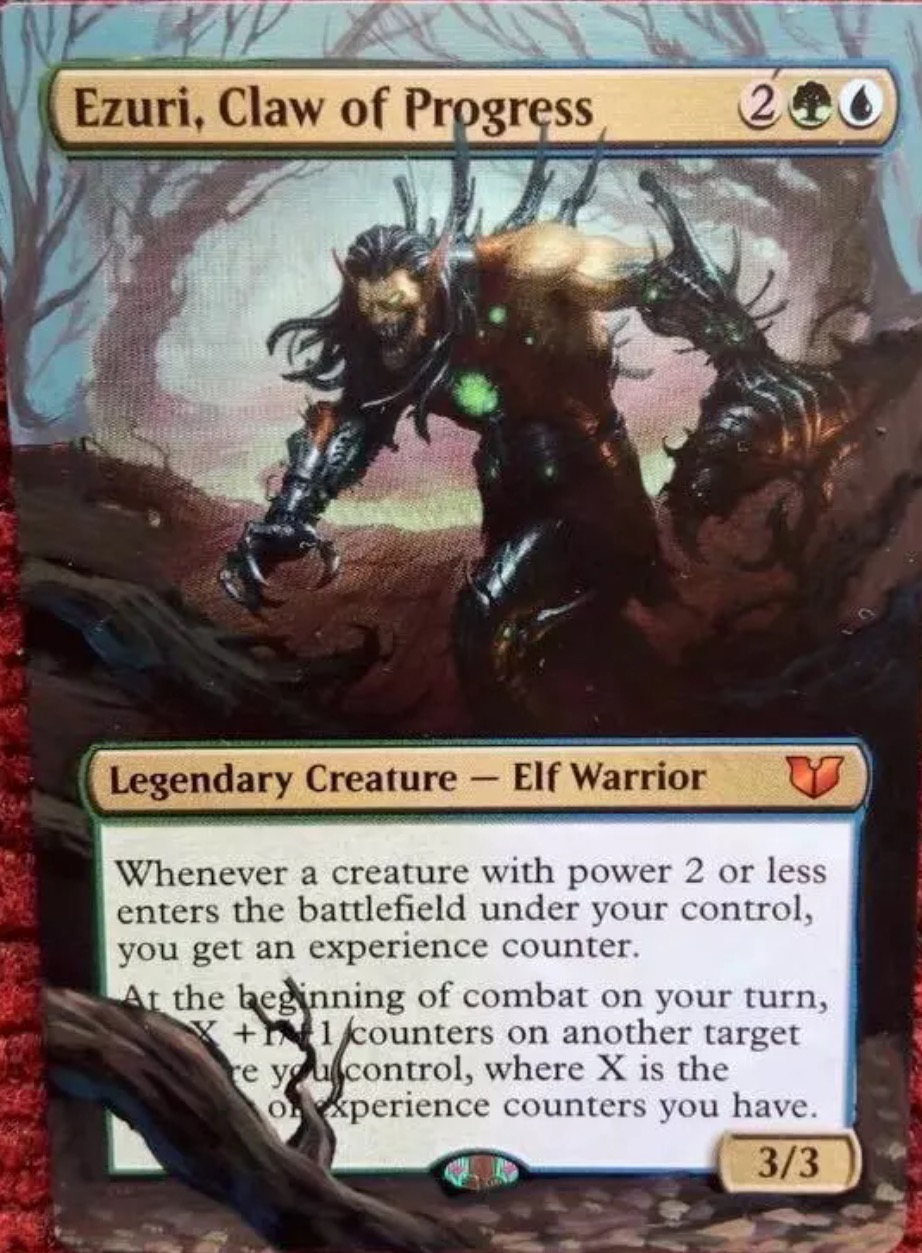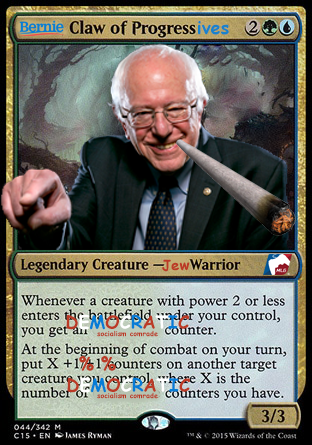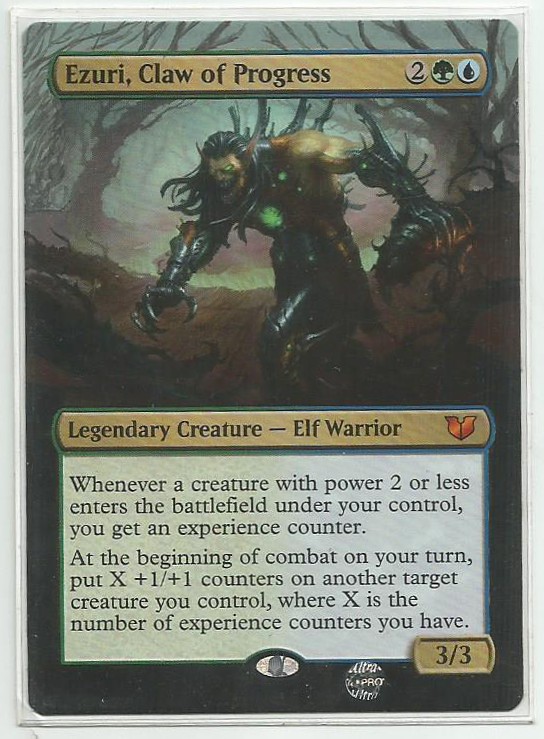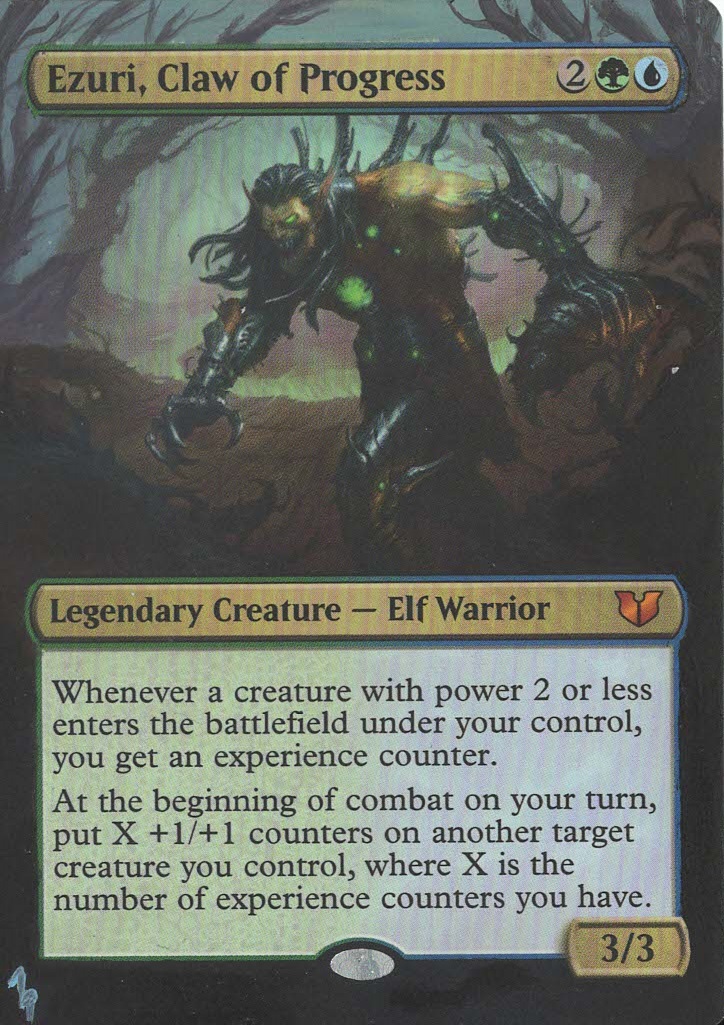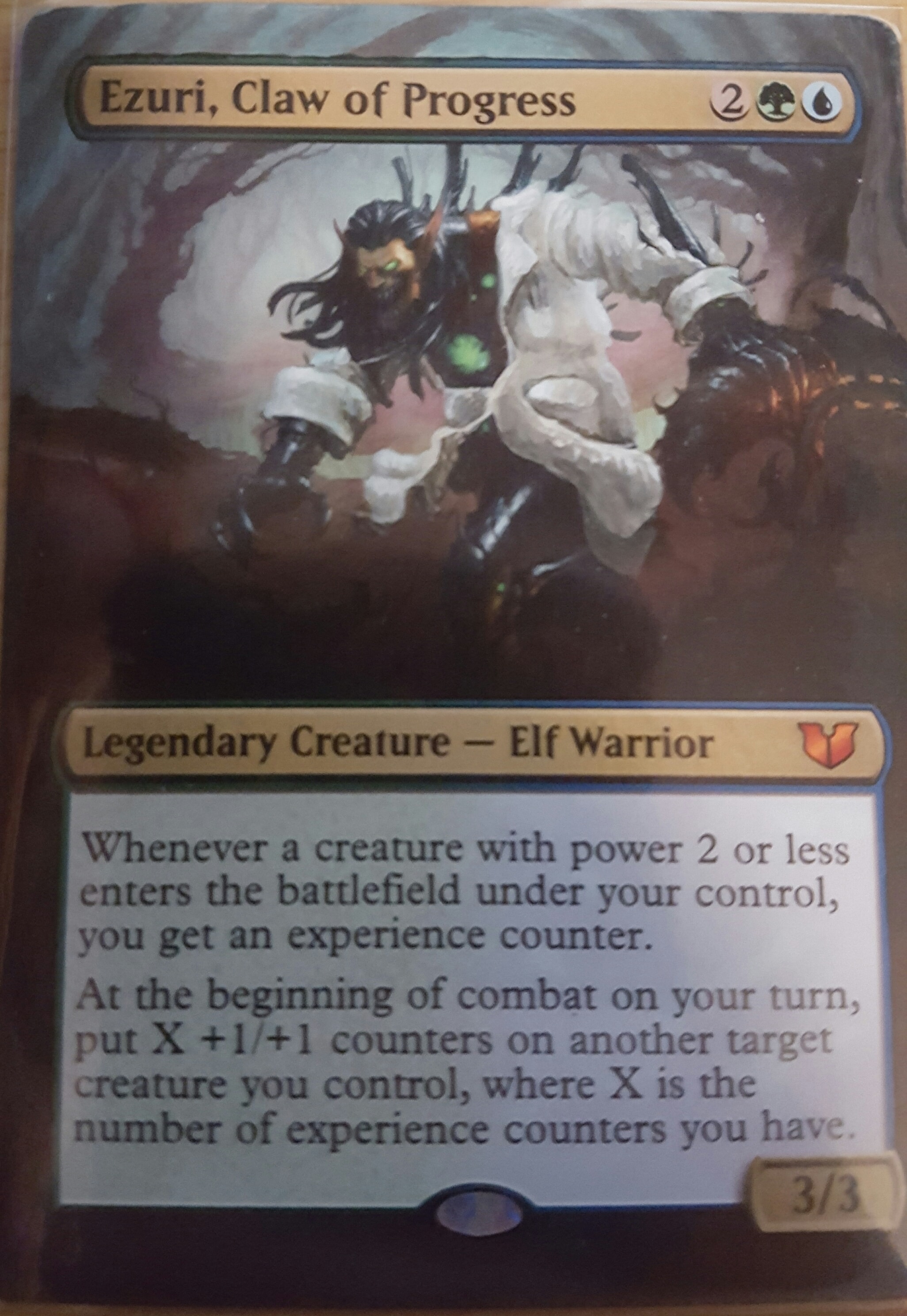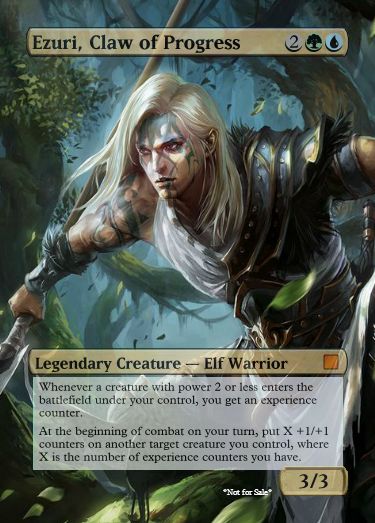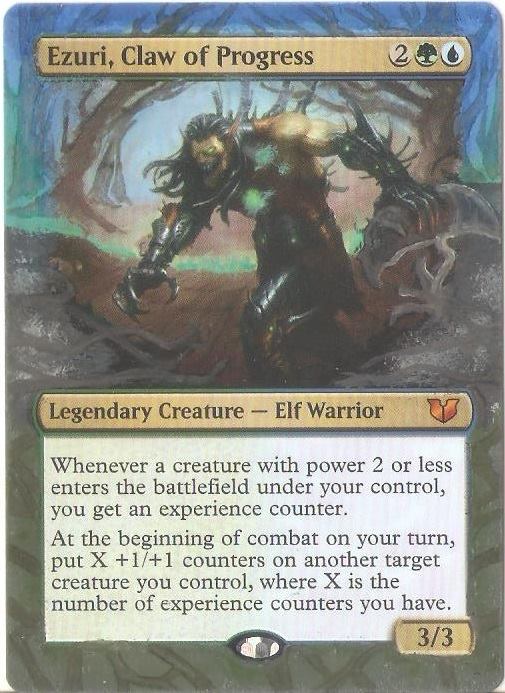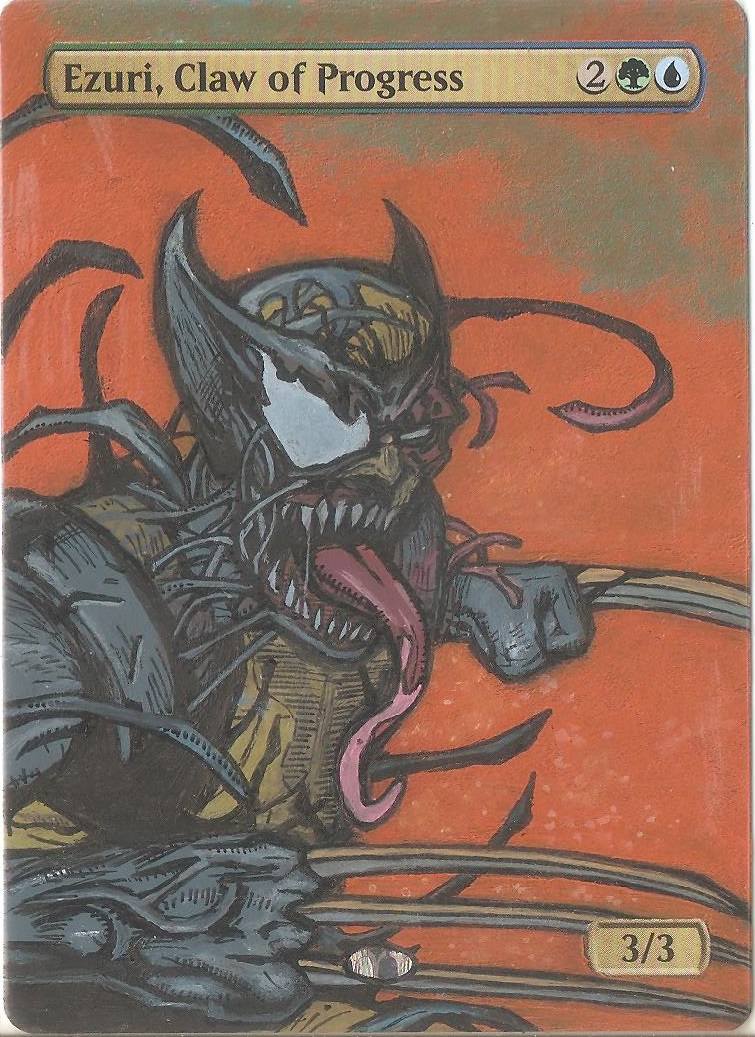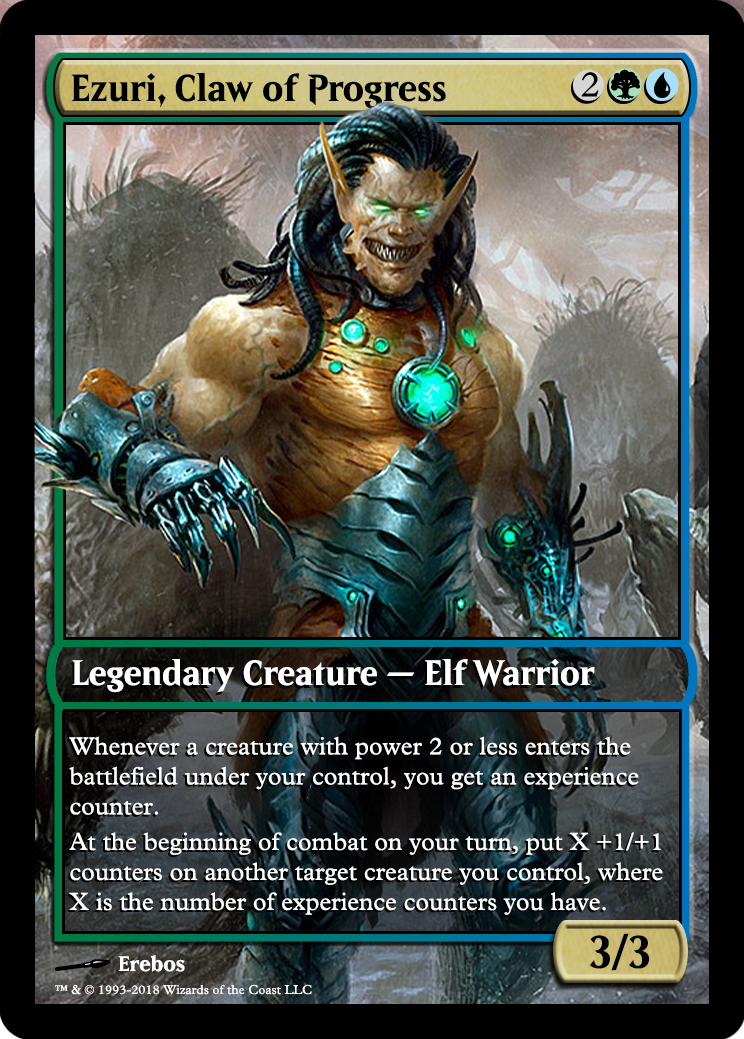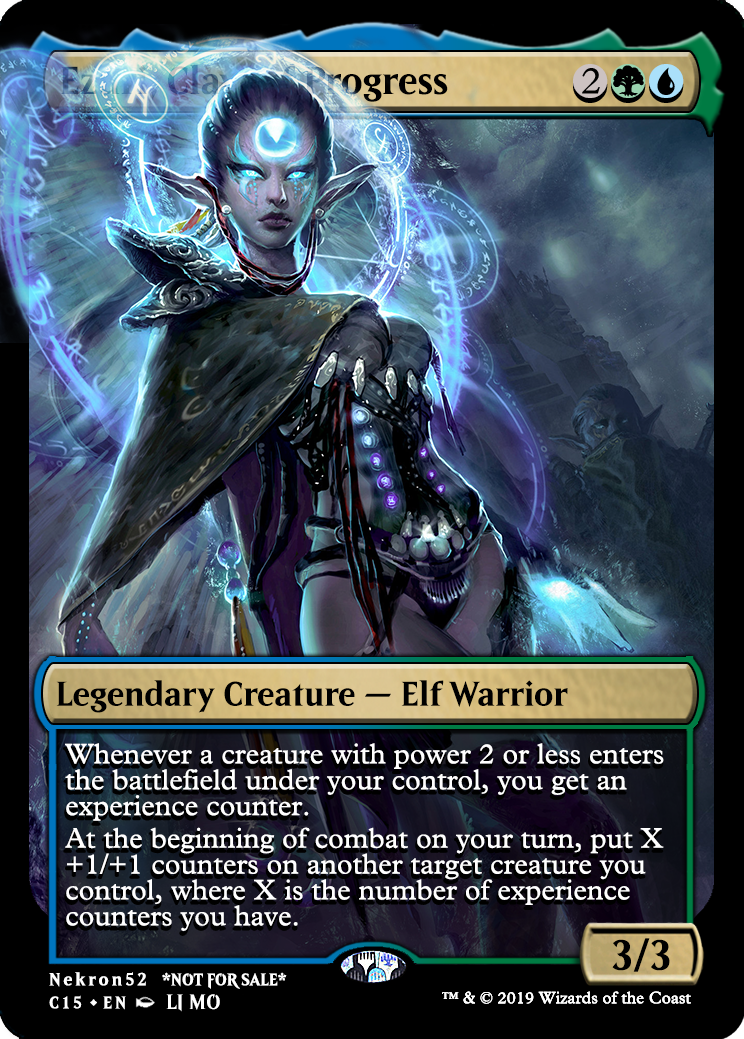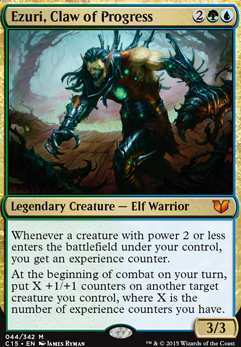
Combos Browse all Suggest
Tokens
Legality
| Format | Legality |
| 1v1 Commander | Legal |
| Archenemy | Legal |
| Canadian Highlander | Legal |
| Casual | Legal |
| Commander / EDH | Legal |
| Commander: Rule 0 | Legal |
| Custom | Legal |
| Duel Commander | Legal |
| Highlander | Legal |
| Legacy | Legal |
| Leviathan | Legal |
| Limited | Legal |
| Oathbreaker | Legal |
| Planechase | Legal |
| Pre-release | Legal |
| Quest Magic | Legal |
| Vanguard | Legal |
| Vintage | Legal |
Rules Q&A
- What happens when I cast Synthetic Destiny, but I have less creature cards in my library then I exiled.
- Would command beacon reset the extra mana for a commander?
- Can you get experience no matter where the commander is.
- When Karn, Silver Golem turns a non-creature into a creature, does that creature "enter" the battlefield?
- Does Simic Keyrune trigger Ezuri, Claw Of Progress
Ezuri, Claw of Progress
Legendary Creature — Phyrexian Elf Warrior
Whenever a creature with power 2 or less enters the battlefield under your control, you get an experience counter.
At the beginning of combat on your turn, put X +1/+1 counters on another target creature you control, where X is the number of experience counters you have.
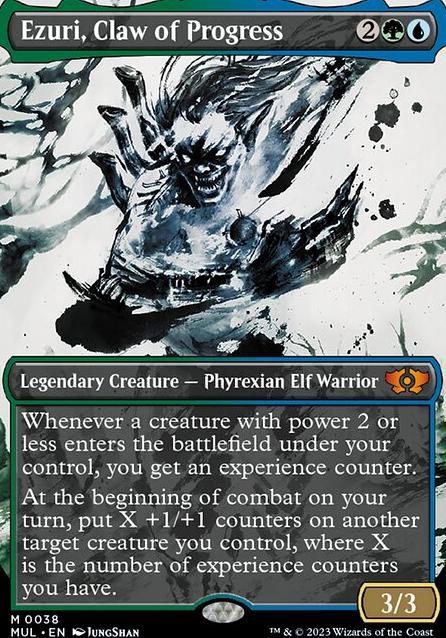



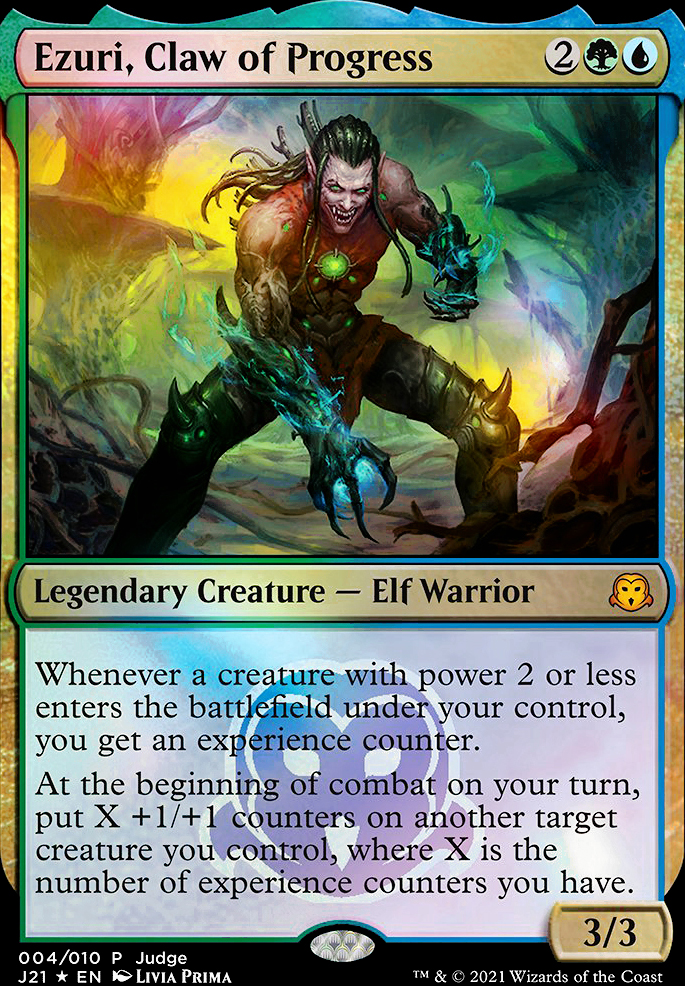

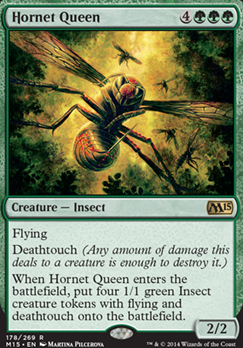
![Fable of Wolf and Owl feature for Tale of Doggo and Birb [UPDATE v5]](http://static.tappedout.net/mtg-cards-2/eventide/fable-of-wolf-and-owl/fable-of-wolf-and-owl-cropped.jpg)

![Atraxa, Praetors' Voice feature for Atraxa, Angel of New Phyrexia [Infect Primer]](http://static.tappedout.net/mtg-cards-2/double-masters/atraxa-praetors-voice/mtg-cards/_user-added/femme_fatale-atraxa-praetors-voice-2xm-15901169910.png)

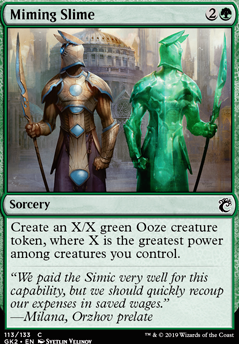


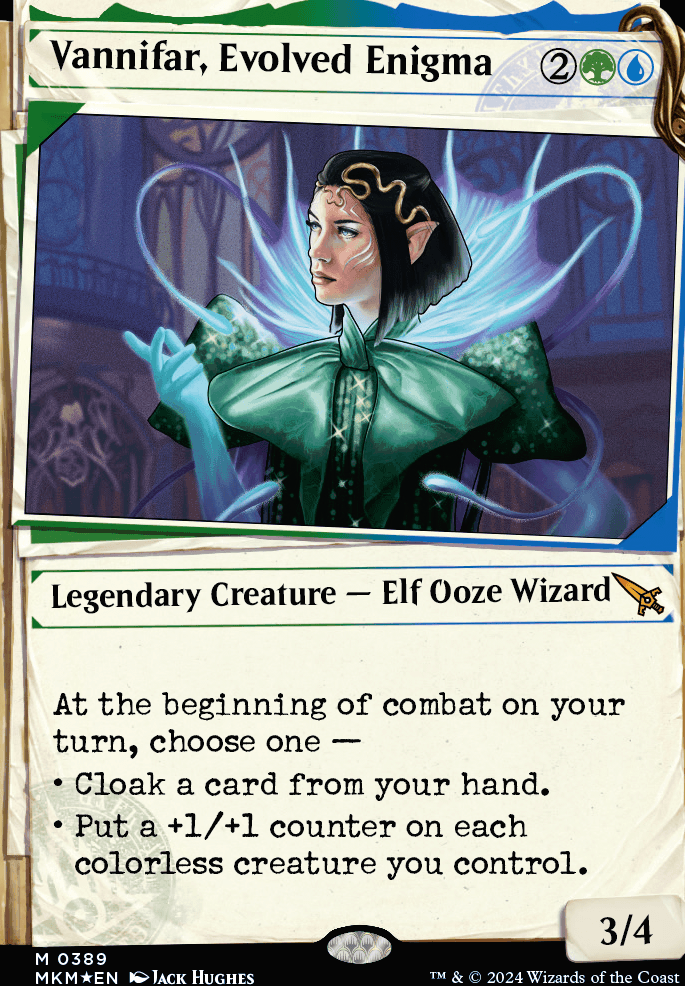
Neotrup on How does Ezuri, claw of …
11 months ago
The creatures enter with the counters. There is no point in which they do not have the counters, so Ezuri, Claw of Progress will not trigger. If the ability used the stack, they would be a 0/0 while waiting for the ability to resolve, which would make them go to the graveyard as a state based action.
Some spells or abilities create a token that's a 0/0 and then immediately give it power and toughness during the resolution. Key examples would be Fractals from Strixhaven or Germs from living weapon equipment. These do enter and exist as a 0/0 during the resolution of the spell or ability creating them, so they will trigger Ezuri, Claw of Progress even though they're larger when Ezuri's ability resolves.
Monomanamaniac on How does Ezuri, claw of …
11 months ago
If I have Ezuri, Claw of Progress in play and I play a Kalonian Hydra, do I get an experience counter? I thought that creatures that had counters on them as they enter the battlefield have those placed on them by a trigger on the stack that can be responded to, which would somehow give ezuri a window to see those creatures as 0/0 by having his ability resolve first. From what I have seen though it looks like those counters basically materialize out of nowhere and there is no way to make it work like that. How can effects like Hardened Scales be able to see the counters being put on the creature?
Maaloufler on
 Hive Mind! (+1/+1 / Tribal The Swarmlord)
Hive Mind! (+1/+1 / Tribal The Swarmlord)
1 year ago
Why not run Ezuri, Claw of Progress? It puts counters on your creatures every combat. Also with the costs you can also run Rosheen Meanderer and Unbound Flourishing
Guerric on Need help with Simic Storm
1 year ago
That's a wicked cool combo Ramble! I'll remember it if I ever build Ezuri, Claw of Progress. If counter storm is what we are going with, cards like the aforementioned Ezuri, lots of proliferate cards likeEvolution Sage, Flux Channeler, and Karn's Bastion. Cards like Hadana's Climb Flip, and payoffs like Sage of Hours, which goes infinite with Ezuri. Having sone ways to blibk Toothy like with Conjurer's Closet or Thassa, Deep-Dwelling are good too.
Guerric on Deck Archetypes in EDH
1 year ago
Hi all! There's an interesting question I've been pondering lately, and I thought I'd share some of my reflections on it and get input from all of you. In sixty card magic we have deck archetypes, namely aggro, control, midrange, combo, and tempo. In commander obviously things look pretty different, and several years ago on the Command Zone podcast they said that like in limited, there aren't really deck archetypes this way, just different flavors of midrange.
As the format has developed and changed a lot over the years I do think something like these archetypes exists in commander, they're just different. For those familiar with sixty card formats some of the hard and fast rules for those archetypes in sixty card magic do not apply, and there certainly is more fluidity on commander and other unique multiplayer strategies as well (ex. Group Hug). Nonetheless, I think the outline of most of these archetypes is still relevant. Here is how I think it plays out-
1) Aggro- I think something more like classic aggro has only become viable in commander in the past couple of years, but I think it is definitely a thing now. In sixty card magic, most creatures are in the one to three drop range, there is often no focus on card draw, and everything in the deck serves to get a single player to zero as quickly as possible. Obviously in commander we need raw engines, some ramp, and are going to play more powerful cards. That being said, I think strategies built around attacking with high value, low cmc creatures from the early game onwards characterizes aggro in commander. This wasn't viable a few years ago due to the lack of board state protection, and really only token pump decks and creature cheat decks tended to do well. But the printing of many premium white board state protection spells like Flawless Maneuver, Teferi's Protection, and Semester's End has changed up the formula a bit. Attacking low to the ground and early is a keystone of aggro strategies, but so are on attack triggers. We have so many of these now, and they incentivize keeping our force swinging every turn. Commanders like Akiri, Fearless Voyager and Trynn, Champion of Freedom incentivize attacking in order to draw cards, make tokens, or do other things the deck is going to want to do. Unlike sixty card magic, we will need to be able to draw cards, and play some removal and interaction, though we'll play fewer pieces of the latter here than in other decks since they compete with resources to keep up the attack. We also need to play one-sided board wipes wherever we have the option, because we can't afford to lose our own board state. We'll also need a way to get through for damage once our opponents' defenses are up, and as such things that give our creatures menace, landwalk, flying, deathtouch or indestructible are key as they help us keep up the assault. We're also very in favor of a few key pump spells to help us finish out the game like Jazal Goldmane or Coat of Arms.
2) Midrange- In sixty card magic midrange is characterized by playing some of the most powerful cards on every point in the curve, and play more removal than aggro decks. Oftentimes they are characterized as "the growing threat." A classic and famous example was the classic Modern Jund deck that Reid Duke piloted several years ago. One of its touchstones was playing Tarmogoyf on turn 2. The goyfs could attack or block where necessary, but they would grow more unstoppable as the game went on, until they were dropping haymakers like Liliana of the Veil. They would use cards like Dark Confidant to keep their hand full till they could inevitably win. In a way, these sorts of decks mirror something of what we see in all commander decks in that they play removal, draw, and powerful cards. Yet what I think sets them apart is this idea of the growing threat, and that they play more removal than aggro decks. One way in which I think some midrange commanders work is to have abilities that allow them to turn other cards into Tarmogoyf like threats. Ezuri, Claw of Progress and Giada, Font of Hope use +1/+1 counters to turn small evasive threates into significant ones. In this sense, I think a lot of counter decks fit well in the midrange categories. These decks will attack, but they don't have to like aggro decks, and are more willing to conserve resources and work on developing board state where feasible. They often have engines that benefit their board passively from the passage of time, and as such they can play more removal and let their board build itself. They still want to protect their board state, and some of the cards from aggro decks that do this or simply counterspells can help with this, and one-sided board wipes are usually th best kind for midrange decks as well.
3) Control- Control decks in sixty card magic are built on trying to shut down almost everything an opponent is trying to do via counterspells and removal until you can work towards a win con. This obviously is not possible in commander where you can not shut down three other players with just counterspells and removal alone, and isn't always necessary since opponents can also shut down each other. As such, controlling strategies fit into two categories: stax and regular control. With stax pieces that shut off lands and mana rocks, eEDH controlling strategies indeed can effectively shut down three other players, usually finding a way to work through it themselves in order to build towards a win con. In standard EDH, heavy land-based stax like that is frowned upon, but cards that disrupt play in other ways (ex. Blind Obedience as well as counterspells and removal are fair game. These decks are still building towards a win con by slowing opponents down, and will devote far more slots to disruption and removal than aggro and midrange decks. They may win with an infinite combo, a planeswalker, a few premium attacking creatures, or in other ways, but most of the deck is devoted to protecting themselves and disrupting opponents. Controlling decks are more likely to play reciprocal board wipes, and generally benefit from keeping the board clear of threats at most times.
4) Combo- Combo decks also exist along a spectrum in EDH, though this archetype is most similar to sixty card magic. The formula is almost unchanged for cEDH, where most of a deck is devoted to playing and protecting a single combo. Outside of cEDH, it is worth mentioning that infinite combos can be included in almost any archetype in the format as a backup win con when other plans go sideways. What makes it a combo deck is that the entire deck is focused on pulling out one of a variety of sometimes elaborate combos, and these decks are generally geared more towards Johnnies than Spikes. A good example would be combo decks built around Teysa, Orzhov Scion that can put together the Darkest Hour in a variety of ways, as well as play Reveillark + Karmic Guide and/or Sanguine Bond + Exquisite Blood in order to win. These decks play out as trying to put together a combo while fending off opponents with removal and interaction.
5) Tempo- Some might argue that there is no such thing as tempo decks in commander, but it's worth mentioning that they're pretty rare even in sixty card magic across formats. In sixty card magic tempo decks adopt a "disruptive aggro" philosophy, where they slowly chip away at an opponent's life total with small, cheap, evasive creatures, while always holding mana open to protect their board and disrupt threats. While "chipping away" life totals isn't much of a strategy in a multiplayer strategy, I do think there are decks that play out along the lines of this disruptive aggro strategy. As an example, Ranar the Ever-Watchful and Alela, Artful Provocateur can be played this way, where the flying tokens they generate are the main win con, and the rest of the deck is devoted to holding mana open to protect this main game plan and stop others from winning. Unlike in sixty card decks these may win all at once with token pump effects or other affects, but this is the main way.
What do you all think? Do you think there are deck archetypes like this in EDH? Why or why not? What qualifications would you add or take away about them if you do?
glhfJKiHax on glhfJKiHax
2 years ago
Been playing Magic since around 2016, exclusively commander, when a friend introduced me.
First deck that I owed was an Ezuri, Claw of Progress and I have had a soft spot for simic ever since.
Moving on from that I searched high and low for a deck to build and when I found Atraxa, Praetors' Voice I knew that the Praetors and the Phyrexians were something I was going to enjoy.
Just recently got myself all the Phyrexian Script Praetors from the secret lair and will be getting my hands on the new Jin the second I can.
Currently tryna slip at least one copy of a Praetor or Phyrexian themed card into everyone of my decks, even if it is just the swamp. Let me know if you have any suggestions on where to fit on in.
Abaques on Need help juggling decks
2 years ago
I need some help figuring out what changes I should make to my decks. I have a deck of every color combo (and more than one of a few color combos) and I've been unhappy with my current Atraxa superfriends deck. I've decided to build a Kethis, the Hidden Hand superfriends build as a replacement. So I need a new deck covering the Witch-Maw colors.
I've got two ideas for that deck:
-
I build an Atraxa deck focusing on alternate win conditions like Darksteel Reactor and Biovisionary. I'd really try to jam in as many alternate win conditions as possible, even ones that would be really difficult to pull off in a four color deck like Happily Ever After.
-
I build a +1/+1 counters deck with Ishai, Ojutai Dragonspeaker and Reyhan, Last of the Abzan. I currently have a +1/+1 counters deck with Ezuri, Claw of Progress at the helm and I'd have to disassemble that deck to build a four color version. My Ezuri deck is solid, but a bit linear.
If I take the second path I'd then want to convert my Ezuri deck into something else. I have a Simic Eldrazi deck piloted by Kruphix, God of Horizons, so I'd be looking for something fun and silly. I have two ideas for Simic decks:
-
A turbo-fog deck piloted by Rashmi, Eternities Crafter. You don't see a lot of turbo-fog in EDH so this would be kind of unique. I am having trouble finding a good win condition aside from Darksteel Reactor though.
-
A zoologist themed Lonis, Cryptozoologist deck where every creature would have a unique type. So since Lonis is a snake elf scout, that means no snakes, elves or scouts. The win-con of that deck would just be to see how many different creature types I could get on the board at once. I think I'd try to throw as many cards that investigated in as well.
I have or could get most of the cards I'd need, though I would want to stay fairly budget for anything I'd need to pick up. I'd really appreciate any advice on which route I should take:
- Build an alt-win con Atraxa deck.
- Build Ishai/Reyhan +1/+1 counters and a Rashmi turbo-fog deck.
- Build Ishai/Reyhan +1/+1 counters and a themed Lonis deck.
- Something else?
Thanks!
Epicurus on Card creation challenge
2 years ago
My personal favorite infinite turns combo is to have Ezuri, Claw of Progress with at least 5 experience counters, and Sage of Hours.
Just in case anyone is lost, the current challenge is a reissue of:
"Make another Ankle Shanker, but in a different Shard or Wedge with appropriate evergreen abilities for your chosen colors.
And if it makes more sense, perhaps do it on blocks. Doesn't need to be attacks as not all colors want to be so aggressive in that regard."
| Have (3) | zachi , JordanSanFran , Azdranax |
| Want (2) | Cicjose , Huncat |






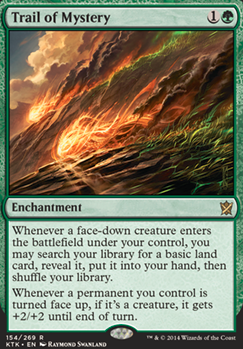
![Atraxa, Angel of New Phyrexia [Infect Primer] thumbnail](http://static.tappedout.net/chart/15-25-25-0-35-small.png)



